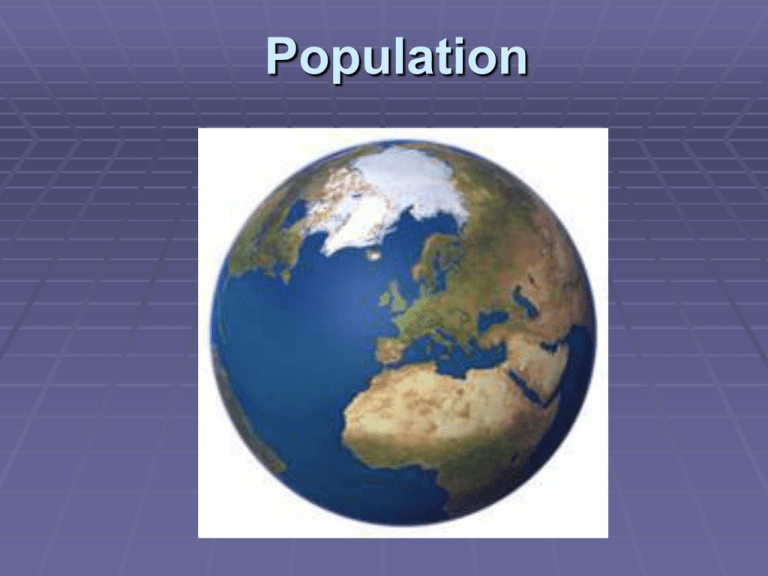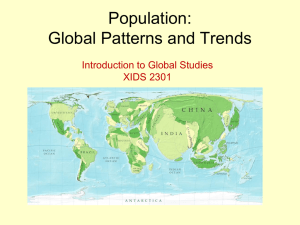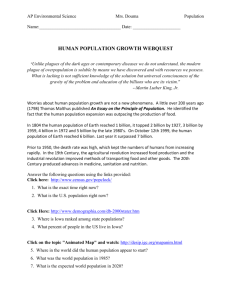Population Overview
advertisement

Population What is Population? The collection of people living in a given geographic area, or space, usually measured by a census Demography The study of human populations Various aspects of human behavior in populations are studied in Sociology, Economics, and Geography The study of populations is almost always governed by the laws of probability www.census.gov/main/www/popclock.html World and Population Statistics World Population: 6.5 Billion-2006 World Population Information World Population Clock 2005 Natural Increase per More Developed Countries Less Developed Countries Less Developed Countries (less China) World Year 80,794,218 1,234,907 79,559,311 71,906,587 Day 221,354 3,383 217,971 197,004 154 2 151 137 Minute Source: Population Reference Bureau, 2005 World Population Data Sheet. World Vital Events Per Time Unit: 2006 Births Year 132,434,587 55,220,152 77,214,435 Month 11,036,216 4,601,679 6,434,536 Day 362,834 151,288 211,546 Hour 15,118 6,304 8,814 Minute 252 105 147 Second 4.2 1.8 2.4 Deaths Natural Increase Worldwide Population Growth Earth’s population hit 1 Billion in the early 1800’s As the world industrialized, people grew more and better food Also, people improved their sanitation methods This combination enabled the population to boom Population Growth What area of the world do you think has the highest rate and lowest rate of population growth from 2000-2005? GeoHive List actual World Population Growth, in Billions Number of years to add each billion (year) First Billion All of Human History Second Third Fourth Fifth (1800) 130 (1930) 30 (1960) 15 (1975) 12 (1987) 12 (1999) Sixth 14 (2013) Seventh Eighth 14 (2027) 21 (2048) Ninth Sources: First and second billion: Population Reference Bureau. Third through ninth billion: United Nations, World Population Prospects: The 2004 Revision (medium scenario), 2005. World Population Growth Through Billions History 12 11 2100 10 9 Old Stone 7 Age 8 New Stone Age Bronze Age Iron Age 6 Modern Age Middle Ages 2000 Future 5 4 1975 3 1950 2 1 Black Death —The Plague 1900 1800 1+ million 7000 6000 5000 4000 3000 2000 1000 A.D. A.D. A.D. A.D. A.D. A.D. years B.C. B.C. B.C. B.C. B.C. B.C. B.C. 1 1000 2000 3000 4000 5000 Source: Population Reference Bureau; and United Nations, World Population Projections to 2100 (1998). Projected Population Change, by Country Percent Population Change, 2005-2050 Source: Population Reference Bureau, 2005 World Population Data Sheet. Global Population Growth: A Developing-Country Phenomenon World population, 1950-2050 (projected) Source: United Nations, World Population Prospects: The 2004 Revision (2005). Trends in Population Growth Worldwide Population Increase and Growth Rate, Five-Year Periods 87 90 80 83 80 2 79 76 76 75 1.8 72 1.4 60 1.2 Millions 50 1 40 0.8 30 0.6 20 0.4 10 0.2 0 0 19801985 19851990 19901995 19952000 Net population added per year 20002005 20052010 20102015 20152020 Annual population growth rate Source: United Nations, World Population Prospects: The 2004 Revision (medium scenario), 2005. Percent increase per year 1.6 70 Notes on Trends in Population Growth Worldwide Over the period 1985-1995, the population growth rate declined (a reflection of declining fertility), yet millions of people were added to the world’s population (which peaked around 1985, when 87 million people were added each year). From 2000 on, the growth rate will continue to decline. Between 2015 and 2020, we will still be adding 72 million people each year. Why? Because the generation of women now having their children is very large as the result of high fertility in their mothers’ and grandmothers’ generations. Birth Rates Birthrate- the number of live births per 1,000 population In 2000, the highest birthrate in the world was more than 54/1000 in Niger Lowest = 8/54 in Latvia World Average = 22/1000 Birth and Death Rates, Worldwide Rates of birth, death, and natural increase per 1,000 population 40 35 30 25 20 Natural Increase 15 10 5 0 1950- 1955- 1960- 1965- 1970- 1975- 1980- 1985- 1990- 1995- 20001955 1960 1965 1970 1975 1980 1985 1990 1995 2000 2005 Birth rate Death rate Source: United Nations, World Population Prospects: The 2004 Revision, 2005. Fertility Rate Shows the average number of children a woman of childbearing years would have in her lifetime A fertility rate of 2.1 is necessary just to replace current population Today, the worldwide average fertility rate is about 3.0 Fertility Rates What do you think the average number of babies each woman has in the world? US? What do you think the highest average is? Where? CIA - The World Factbook -- Rank Order Total fertility rate 10 Places With the Lowest Total Fertility Worldwide Average number of children per woman, 2000-2005 China, Macao Special Administrative Region China, Hong Kong Special Administrative Region Ukraine Czech Republic Slovakia 0.84 0.94 1.12 1.17 1.20 Slovenia 1.22 Republic of Korea 1.23 Republic of Moldova 1.23 Bulgaria 1.24 Belarus 1.24 Source: United Nations, World Population Prospects: The 2004 Revision, 2005. Women of Childbearing Age Number of Women 15 to 49 Billions 1.98 2.06 1.76 1.32 0.86 0.62 1950 1970 1990 2010 2030 2050 Source: United Nations, World Population Prospects: The 2004 Revision (medium scenario), 2005. Women of Childbearing Age and Fertility Worldwide 3 6 2.0 2 2.0 Billions 1.8 4 3 1.3 0.9 1 2 0.6 1 0 0 1950-1955 1970-1975 1990-1995 2010-2015 2030-2035 2045-2050 Women 15 to 49 Average number of children per woman Source: United Nations, World Population Prospects: The 2004 Revision (medium scenario), 2005. Children per woman 5 Diverging Trends in Fertility Reduction Average number of children per woman 8.5 6.4 6.4 5.7 5.4 6.2 5.3 5.2 4.3 3.3 3.1 2.4 Egypt India 2.5 2.1 Indonesia Iran 1970-1975 Pakistan 2000-2005 Source: United Nations, World Population Prospects: The 2004 Revision, 2005. Turkey Yemen Questions to Consider Why is the world’s population increasing but the growth rate is decreasing? Why is the world’s population growing so quickly? What problems/implications does this growth bring about? Mortality Rate Also called the death rate Number of deaths per 1,000 people Generally, a society is considered healthy if it has a low mortality rate However, some healthy nations have higher mortality rates because they have large numbers of elderly people Birth and Death Rates, Worldwide Rates of birth, death, and natural increase per 1,000 population 40 35 30 25 20 Natural Increase 15 10 5 0 1950- 1955- 1960- 1965- 1970- 1975- 1980- 1985- 1990- 1995- 20001955 1960 1965 1970 1975 1980 1985 1990 1995 2000 2005 Birth rate Death rate Source: United Nations, World Population Prospects: The 2004 Revision, 2005. Life Expectancy How long a person is expected to live Which countries do you think have the highest and lowest life expectancy at birth? GeoHive List actual Trends in Life Expectancy, by Region Life Expectancy at Birth, in Years 82 80 77 76 72 65 67 75 65 49 Africa Asia Latin America and the Caribbean 2000-2005 More Developed Regions 2045-2050 Source: United Nations, World Population Prospects: The 2004 Revision (medium scenario), 2005. World Infant Mortality Rate For this reason, geographers also look at infant mortality rates Infant Mortality Rate Shows the number of deaths among infants under age 1 per 1,000 live births In the 1800’s, the worldwide I.M.R. was 300/1,000 Rate of Natural Increase Birthrate – Death Rate B-D = R A.K.A. = Population Growth Rate Birth and Death Rates, Worldwide Rates of birth, death, and natural increase per 1,000 population 40 35 30 25 20 Natural Increase 15 10 5 0 1950- 1955- 1960- 1965- 1970- 1975- 1980- 1985- 1990- 1995- 20001955 1960 1965 1970 1975 1980 1985 1990 1995 2000 2005 Birth rate Death rate Source: United Nations, World Population Prospects: The 2004 Revision, 2005. Human Population Growth Rate Population Pyramid Another way to analyze populations is to use a population pyramid PP = a graphic device that shows sex & age distribution of a population Allows geographers to examine how events in society, such as wars, famine, or epidemics, affect the population of a country or region Age Distribution of the World’s Population Population Structures by Age and Sex, 2005 Millions Less Developed Regions More Developed Regions Age Male 300 200 100 Female 0 100 200 300 80+ 75-79 70-74 65-69 60-64 55-59 50-54 45-49 40-44 35-39 30-34 25-29 20-24 15-19 10-14 5-9 0-4 Male 300 100 Source: United Nations, World Population Prospects: The 2004 Revision, 2005. Female 100 300 Population Density The average number of people who live in a measurable area, such as a square mile The number is reached by dividing the number of inhabitants in an area by the total amount of land they occupy Geographers use this to understand how heavily populated an area is Which countries do you think are the most densely populated? GeoHive List actual Population Density This number can be misleading for an entire nation Why? Example: U.S. P.D. 1990 Alaska= huge land area, small population 1 person per square mile New Jersey= small land area, large population 1,098 people per square mile Total U.S. Population Density = 70.3 people per square mile Carrying Capacity The number of individuals an environment can support without significant negative impacts A region with fertile land may be able to support far more people than one with land of poor quality or with little land available for cultivation Technology Level of technology of a group living on the land may affect carrying capacity Carrying Capacity Land Area Write what you think the five largest countries(land area) are. GeoHive List actual Population Distribution Of the billions of people in the world, most are not distributed equally across the earth Some lands are not suitable for human habitation Examples? Almost 90% of the world’s population lives in the Northern Hemisphere N.H.- ½ of the planets surface, which is north of the equator Population Distribution 1 in 4 people in the world live in East Asia, and 1 in 2 people live in either East Asia or South Asia Factors: Climate Altitude Access to water All influence where people live Urban-Rural Mix Currently, more than ½ of the world’s population lives in rural areas However, this number is changing rapidly More and more people are migrating to cities Particularly, cities with populations of more than one million people Trends in Urbanization, by Region Urban Population 85 Percent 82 76 74 61 55 54 53 47 42 37 37 29 17 15 World Africa Asia 1950 2000 Latin America and the Caribbean More Developed Regions 2030 Source: United Nations, World Urbanization Prospects: The 2003 Revision (medium scenario), 2004. World Population by Country List what you think the top ten populated countries in the world were/are/will be in 1950, 2006 and 2050. GeoHive GeoHive List actual Population Density (people/ km²) Rank Country — World 6,661,208,350 43 1 China 1,315,844,000 136 2 India 1,110,000,000 328 3 United States 300,000,000 30 4 Indonesia 222,781,000 126 5 Brazil 186,405,000 21 6 Pakistan 164,000,000 202 7 Bangladesh 145,000,000 1,002 8 Russia 142,800,000 8 9 Nigeria 131,530,000 139 10 Japan 127,000,000 337 11 Mexico 107,000,000 54 Population development of the largest countries from 1950 to 2050 Largest Metropolitan Areas List what you think the 10 largest metropolitan areas are in world. GeoHive List Actual GeoHive --2015 Projected GeoHive --1950-2015 Met. Areas Megacities In 1950, New York City was the only World City with more than 10 million residents Today, 26 giant cities are home to a total of more than 250 million people The largest of these is Tokyo 34 million inhabitants These huge cities struggle with overcrowded conditions and immense demand for water & sanitation Largest Cities List what you think the 10 largest cities are in world. GeoHive List actial Tokyo Mexico City Seoul, South Korea Shanghai, China Migration The large-scale migration of people from one location to another also alters the distribution of population Reasons for migrating are referred to as: PushPull Factors Immigration Immigration- the movement of people from one nation-state to another Immigration implies long-term permanent residence by the immigrants Tourists are not considered immigrants All of our ancestors immigrated to America from a foreign country In 1990, Almost Half of All U.S. Counties Had Less Than 1% Foreign-Born, and Only One-Tenth Had 5% or More. Source: U.S. Census Bureau, 1990 decennial census. By 2000, Only One-Fourth of U.S. Counties Had Less Than 1% Foreign-Born, and One in Five Had 5% or More. Source: U.S. Census Bureau, 2000 decennial census. Push Factors Push Factors- those that cause people to leave their homeland & migrate or immigrate to another region or country Drought Natural Disasters Political – war, persecution Religious Reasons Economic Opportunity Irish Potato Famine (1845-1849) Natural Disasters Hurricane Katrina Migration Religious Persecution Pull Factors Pull factors draw or attract people to another location Why would someone from Harlan, IA be “pulled” to Chicago or Kansas City? Why were our ancestors “pulled” to America? Countries with good economic opportunities & high salaries are the likely destinations of migrants & immigrants Favorable Climate is another pull factor. “Snow Birds” GDP List the countries that you think have the top five GDP. GeoHive: GDP - Top 50 for 2004 & 2005 List actual GDP—Per Capita Income List what you think the highest and lowest per capita income is in the world. What do you think the per capita income is in the US? GeoHive Imports/Exports Which countries have the most exports? GeoHive Which countries have the most imports? GeoHive Why is it important to have a trade balance? How does the US fair? Internet and Computer Users GeoHive --Computer users GeoHive --Internet Users What does this info tell us? Oil Reserves, Production and Consumption GeoHive –Oil reserves GeoHive –Oil production GeoHive –Oil consumption Energy Consumption GeoHive What conclusions can be made from the last two slides? Millennium Development Goals United Nations Millennium Development Goals Passed in 2000, the eight Millennium Development Goals form a blueprint agreed to by all the world’s countries and all the world’s leading development institutions The target year to achieve these goals is 2015 Goal #1: Eliminate Extreme Hunger and Poverty Reduce by half the proportion of people living on less than a dollar a day Reduce by half the proportion of people who suffer from hunger % Living on less than $1/ Day % of People Living in Poverty Goal #2: Achieve Universal Primary Education Ensure that all boys and girls complete a full course of primary schooling Goal #3: Promote Gender Equality and Empower Women Eliminate gender disparity in primary and secondary education preferably by 2005, and at all levels by 2015 Goal #4: Reduce Child Mortality Reduce by two thirds the mortality rate among children under five Goal #5: Improve Maternal Health Reduce by three quarters the maternal mortality ratio Goal #6: Combat HIV/AIDS, Malaria and Other Diseases Halt and begin to reverse the spread of HIV/AIDS Halt and begin to reverse the incidence of malaria and other major diseases Goal #7: Ensure Environmental Sustainability Integrate the principles of sustainable development into country policies and programs; reverse loss of environmental resources Reduce by half the proportion of people without sustainable access to safe drinking water Achieve significant improvement in lives of at least 100 million slum dwellers, by 2020 Goal #8: Develop a Global Partnership for Development Develop further an open trading and financial system that is rule-based, predictable and non-discriminatory, includes a commitment to good governance, development and poverty reduction— nationally and internationally Address the least developed countries' special needs. This includes tariff- and quota-free access for their exports; enhanced debt relief for heavily indebted poor countries; cancellation of official bilateral debt; and more generous official development assistance for countries committed to poverty reduction Address the special needs of landlocked and small island developing States Deal comprehensively with developing countries' debt problems through national and international measures to make debt sustainable in the long term In cooperation with the developing countries, develop decent and productive work for youth In cooperation with pharmaceutical companies, provide access to affordable essential drugs in developing countries In cooperation with the private sector, make available the benefits of new technologies— especially information and communications technologies Now that you have seen the eight goals, how are these goals coming along six years later(2006)? Using the MDG Goals Report-2006, discuss how the goals are being met or how they aren’t. http://unstats.un.org/unsd/mdg/Resources/ Static/Products/Progress2006/MDGReport 2006.pdf 1. 1 2 2 2 3 3 4 4 4 1. 1 2 2 2 3 3 4 4 4 5 6 Availability of Doctors, Selected Countries 1997-2004* Physicians per 1,000 people Cuba 5.9 Greece 4.4 U.S. 2.3 Jordan 2.0 1.6 China Mexico 1.5 Bolivia Bangladesh Cambodia Mali 1.2 0.3 0.2 0.1 * Data are for the most recent year available for each country. Source: World Bank, World Development Indicators 2006. 6 6 6 7 7 7 7 7 7 7 8 8 8 8 8 Population Control



